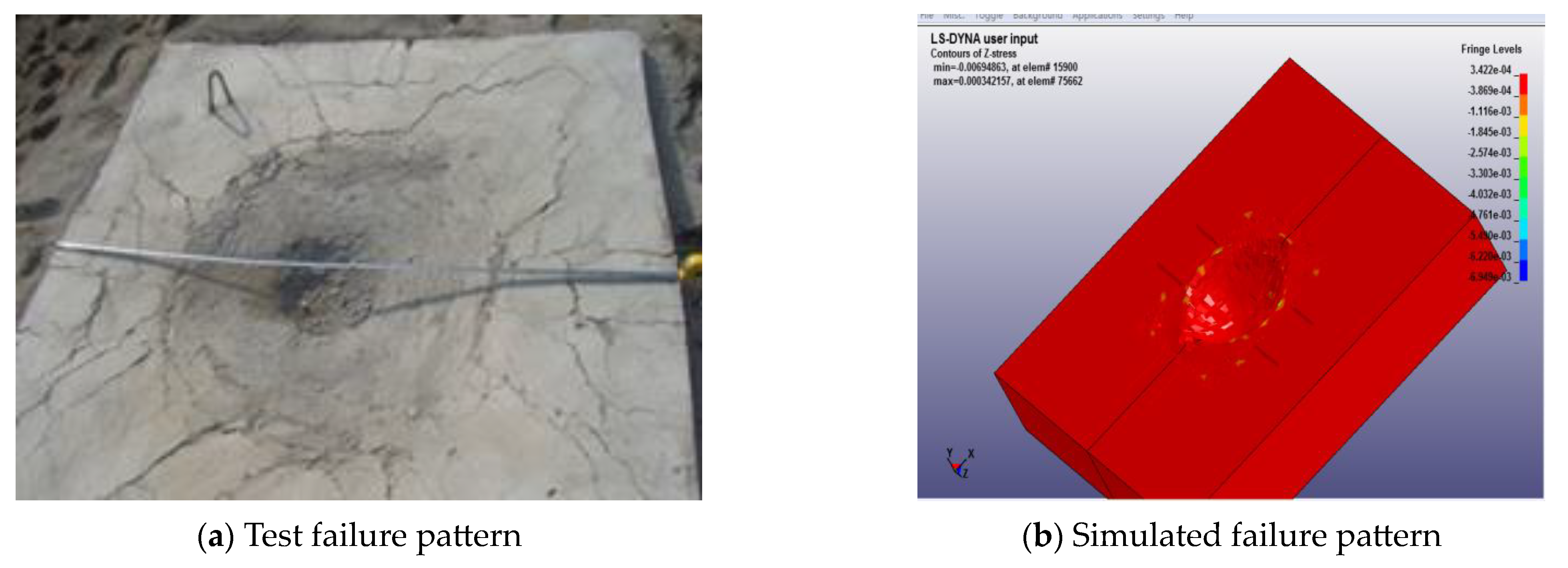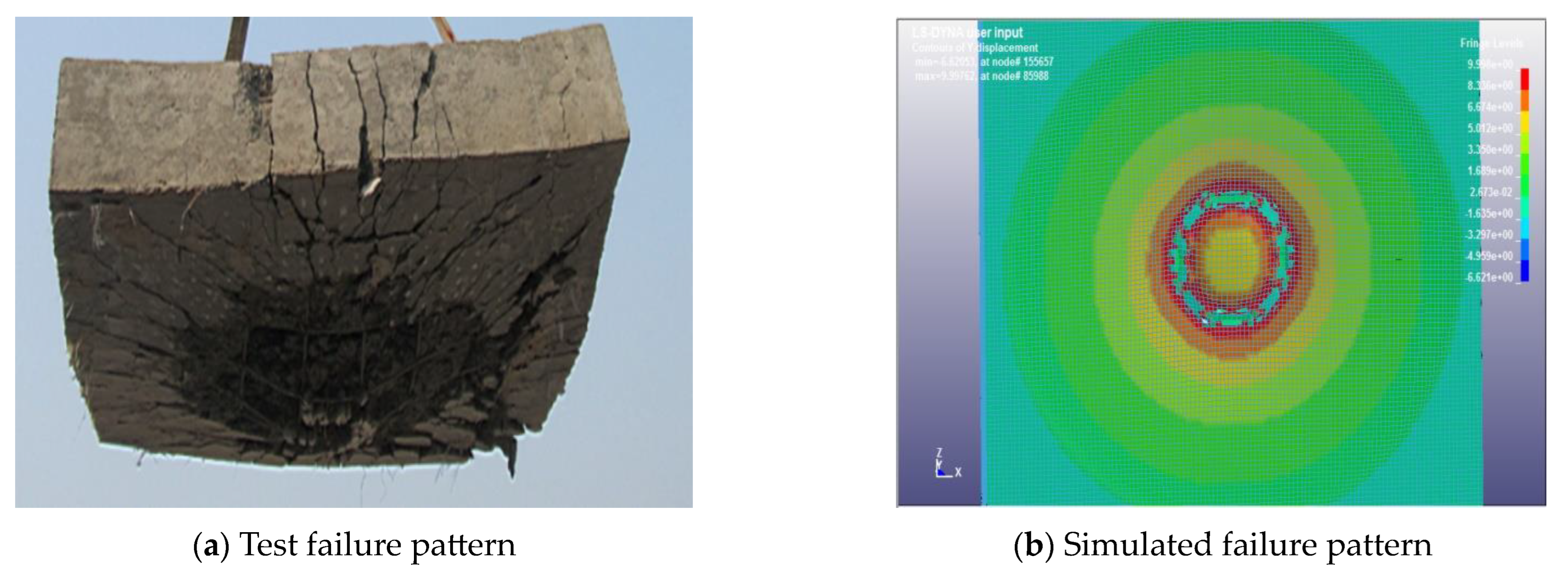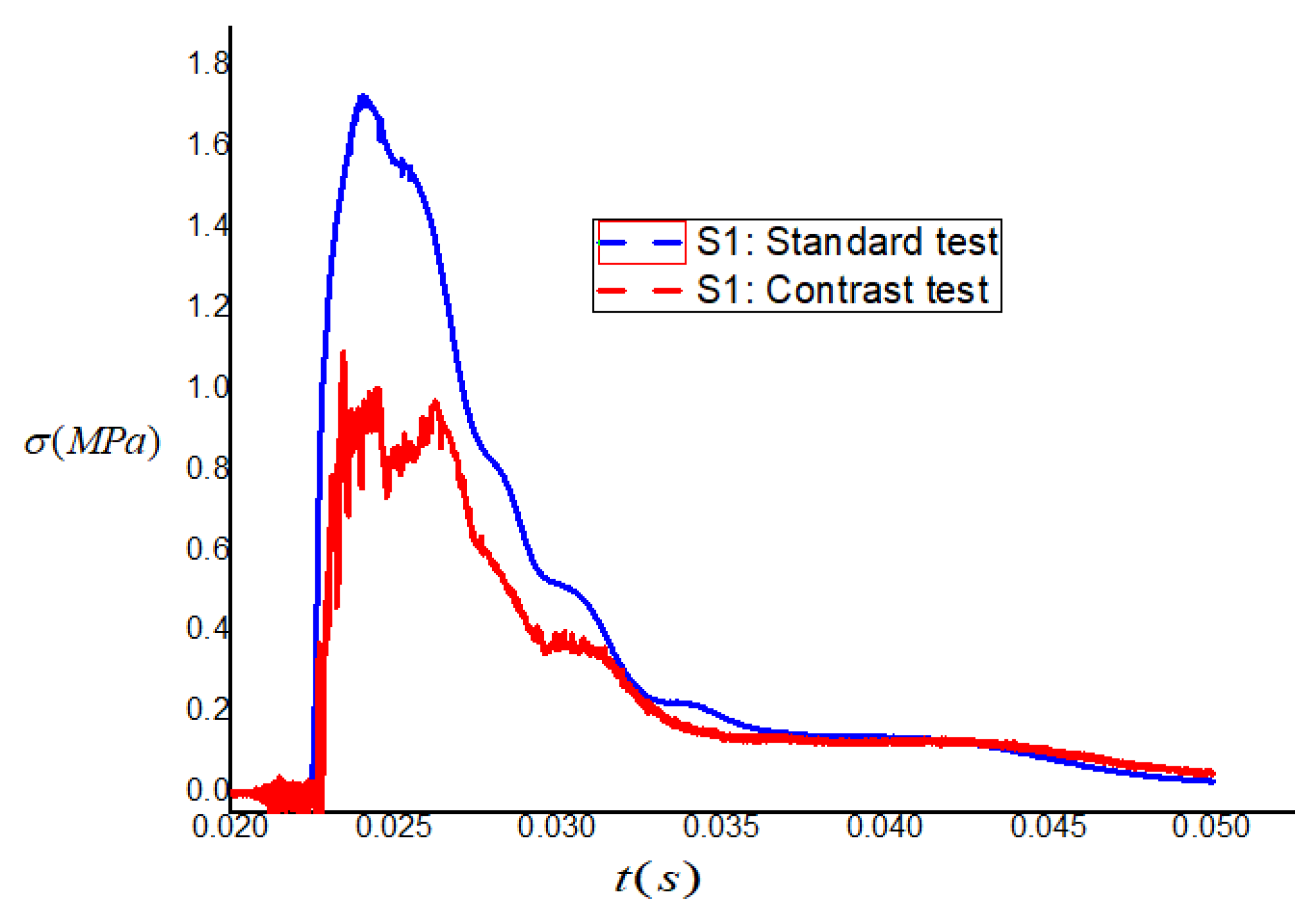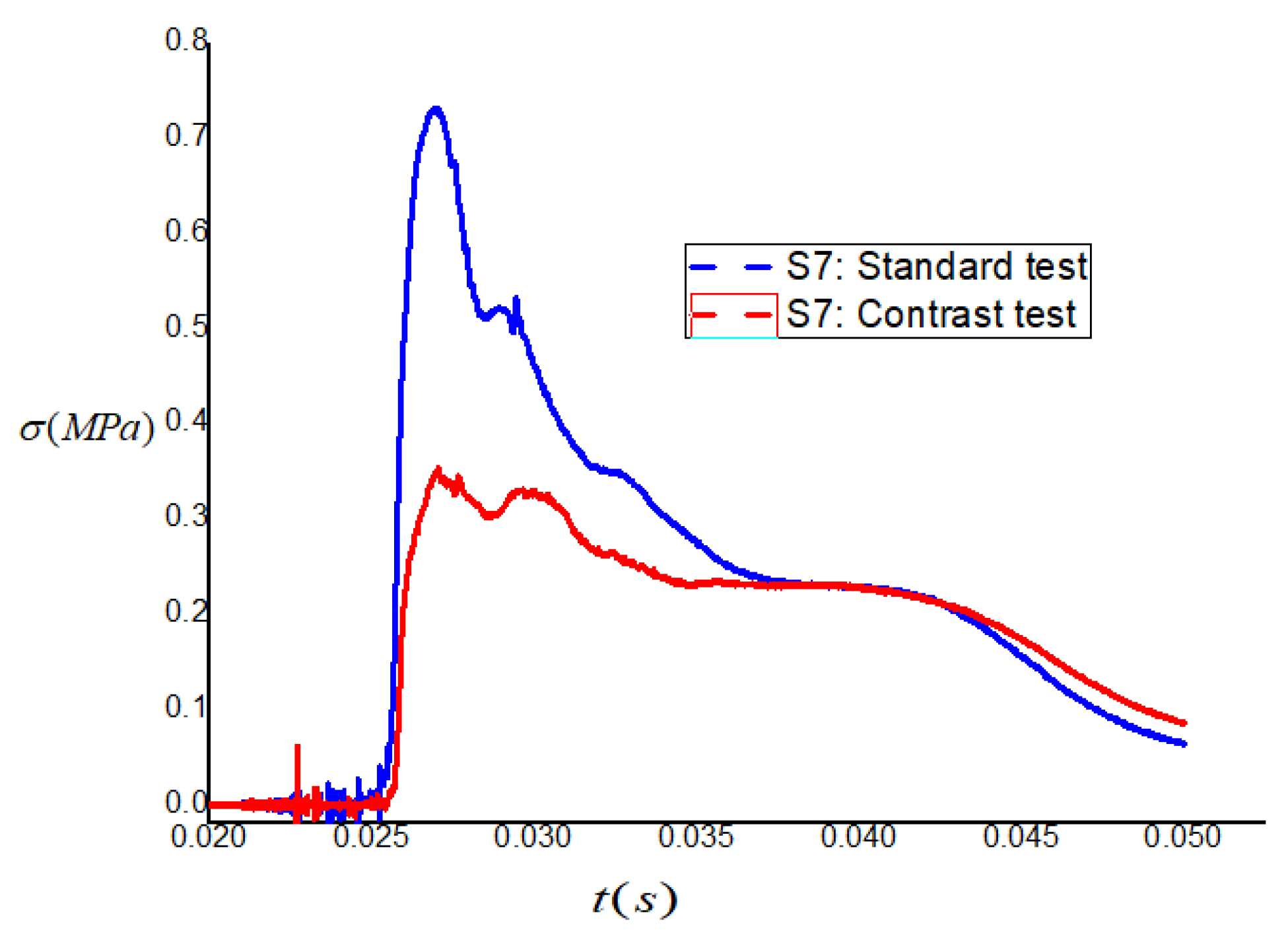Field Test and Numerical Simulation of a New Layered Structure
Abstract
:1. Introduction
2. Experimental Program
2.1. Model Scale
2.2. Bulletproof Board Design
2.3. Distribution Layer Design
2.3.1. Standard Test: Test 1
2.3.2. Contrast Test: Test 2
2.4. Centralized Charge Loading [32]
2.5. Numerical Calculation Model
3. Numerical Calculation of Material Parameters and Results
4. Experimental Results
4.1. Comparison of the Failure Modes
4.2. Peak Stress Contrast
4.3. Energy Analysis
4.4. Analysis of the Test Results
5. Conclusions
- (1)
- The distribution layer constructed by the hollow particle composite material had a strong attenuation and dispersion effect on the shock wave. Under the same test conditions, the peak stress was 0.47 times that of the distribution layer made of sand. The stress wave rose along a large margin, the pulse width increased, and the wave dispersion was serious, which indicated that the distribution layer made of hollow particle composite material had an efficient energy absorption and wave elimination effect.
- (2)
- Under the same test conditions, the back of the shield layer above the distribution layer of the empty shell particle composite material had serious deformation and damage, which was also one of the reasons why the distribution layer of the empty shell particle composite material could improve the protection function of civil air defense engineering applications.
- (3)
- The experiment showed only a small number of particles and the surface layer of foam ceramics was slightly damaged, suggesting that the shell particle composite layer distribution after blasting damage was very small. The role of the explosion load could be handled again, helping to improve the ability of civil air defense engineering under repeated blows.
Author Contributions
Funding
Data Availability Statement
Acknowledgments
Conflicts of Interest
References
- Li, Y.C. Intelligent protective layer design and underground structure coupling response study. Rep. China’s Natl. Def. Sci. Technol. 2016, 1–10. [Google Scholar]
- Gao, G.F.; Li, Y.C.; Yao, L. Test study on cavity structure’s defense effect against nuclear explosion loadings. J. Civ. Eng. 2010, 43, 490–493. [Google Scholar]
- Zhao, K.; Luo, W.C.; Li, X.Y.; Liu, F.; Wang, X.J. Experimental Study of Explosion Load Bearing Performance of Shelly Cellular Material Used in Civil Defense Engineering. J. Exp. Mech. 2012, 27, 189–194. [Google Scholar]
- Li, X.Y.; Li, Y.C.; Zhao, K.; Gao, G.F. Mechanical Properties of Sialic Foamed Ceramic and Applications in Defense Structure. Chin. Phys. Lett. 2014, 31, 086201. [Google Scholar] [CrossRef]
- Shen, J.; Li, Y.C.; Yao, L.; Hu, X.Z. Hole diffraction isolation effect and weaken the effect of rear stress wave. Explos. Shock Waves 2005, 25, 193–199. [Google Scholar]
- Zhao, K.; Wang, X.J.; Liu, F.; Luo, W.C. Propagation of stress wave in porous material. Explos. Shock Waves 2011, 31, 107–112. [Google Scholar]
- Li, X.Y. Static and Dynamic Mechanical Properties of Pore Engineering Materials Research and Application in Protective Engineering; University of Science and Technology of China: Hefei, China, 2014. [Google Scholar]
- Ren, X.J.; Zhang, L. Foam ceramic hollow ball for distribution of layer type protective structure anti-knock performance test research. Prot. Eng. 2015, 37, 12–16. [Google Scholar]
- Ye, Z.B.; Li, Y.C.; Zhao, K.; Huang, R.Y.; Zhang, Y.L.; Sun, X.W. New Form of Equivalent Constitutive Model for Combined Shell Particle Composites and Its Application in Civil Air Defense. Int. J. Civ. Eng. Trans. A Civ. Eng. 2019, 17, 555–561. [Google Scholar] [CrossRef]
- Attar, A.A.; Kazemi, M. Novel geometric arrangement effects on energy absorption of a conical structure with various cross-sections. Thin-Walled Struct. 2022, 173, 109005. [Google Scholar] [CrossRef]
- Zhou, H.Y.; Zhang, X.J.; Wang, X.J.; Zhang, H.; Song, T.Y. Improving energy absorption capacity of foam concrete with gradient and layered architecture. Constr. Build. Mater. 2022, 319, 126140. [Google Scholar] [CrossRef]
- Xiang, X.M.; Zou, S.M.; Ha, N.S.; Lu, G.X.; Kong, I. Energy absorption of bio-inspired multi-layered graded foam-filled structures under axial crushing. Compos. Part B Eng. 2020, 198, 108216. [Google Scholar] [CrossRef]
- Ji, M.J.; Guo, Y.F.; Han, X.X.; Fu, Y.G.; Kang, J.F.; Wei, Q. Dynamic cushioning energy absorption of paper composite sandwich structures with corrugation and honeycomb cores under drop impact. J. Sandw. Struct. Mater. 2022, 24, 1270–1286. [Google Scholar] [CrossRef]
- Liu, K.L.; Chen, C.X.; Guo, W.B.; Liu, B.X.; Yang, B.C.; Li, Z.Y.; Li, J.W.; Li, X.H.; Yin, F.X. Energy absorption and deformation behavior of multilayer aluminum foam structures. Mater. Sci. Eng. A 2022, 832, 142470. [Google Scholar] [CrossRef]
- Song, J.L.; Hu, D.W.; Luo, S.M.; Wang, D.F.; Sun, Q.S.; Zhang, G.P. Energy-absorption behavior of metallic hollow sphere structures under impact loading. Eng. Struct. 2021, 226, 111350. [Google Scholar] [CrossRef]
- Luo, W.M.; Shi, S.Q.; Chen, Z.P.; Sun, J.H. Influence of Layer Configuration on the Energy Absorption of Layered Aluminum Honeycomb. Mater. Rev. 2017, 31, 82–87. [Google Scholar]
- Tao, Y.; Chen, M.; Pei, Y.; Fang, D. Strain rate effect on mechanical behavior of metallic honeycombs under out-of-plane dynamic compression. J. Appl. Mech. 2015, 82, 021007. [Google Scholar] [CrossRef]
- Tao, Y.; Chen, M.; Chen, H.; Pei, Y.; Fang, D. Strain rate effect on the out-of-plane dynamic compressive behavior of metallic honeycombs: Experiment and theory. Compos. Struct. 2015, 132, 644–651. [Google Scholar] [CrossRef]
- Tao, Y.; Duan, S.; Wen, W.; Pei, Y.; Fang, D. Enhanced out-of-plane crushing strength and energy absorption of in-plane graded honeycombs. Compos. Part B Eng. 2017, 118, 33–34. [Google Scholar] [CrossRef]
- Liu, D.; Shi, X.; Zhang, X. Hydraulic fracturing test with prefabricated crack on anisotropic shale: Laboratory testing and numerical simulation. J. Pet. Sci. Eng. 2018, 168, 409–418. [Google Scholar] [CrossRef]
- Hashmi, S.J.; Al-Hassani, S.T.S.; Johnson, W. Dynamic plastic deformation of rings under impulsive load. Int. J. Mech. Sci. 2012, 14, 823–826. [Google Scholar] [CrossRef]
- Fan, Z.; Shen, J.; Lu, G.; Ruan, D. Dynamic lateral crushing of empty and sandwich tubes. Int. J. Impact Eng. 2013, 53, 3–16. [Google Scholar] [CrossRef]
- Qiao, J.; Chen, C. Impact resistance of uniform and functionally graded auxetic double arrowhead honeycombs. Int. J. Impact Eng. 2015, 83, 47–58. [Google Scholar] [CrossRef]
- Zhang, Y.; Chen, T.; Xu, X.; Hu, Z. Out-of-plane mechanical behaviors of a side hierarchical honeycomb. Mech. Mater. 2020, 140, 103227. [Google Scholar] [CrossRef]
- Meng, Y.; Lin, Y.; Zhang, Y.; Li, X. Study on the dynamic response of combined honeycomb structure under blast loading. Thin-Walled Struct. 2020, 157, 107082. [Google Scholar] [CrossRef]
- Hatami, H.; Rad, M.S.; Jahromi, A.G. A theoretical analysis of the energy absorption response of expanded metal tubes under impact loads. Int. J. Impact Eng. 2017, 109, 224–239. [Google Scholar] [CrossRef]
- Deshpande, V.S.; Fleck, N.A. Isotropic constitutive models for metallic foams. J. Mech. Phys. Solids 2000, 48, 1253–1283. [Google Scholar] [CrossRef] [Green Version]
- Zhang, X.-C.; An, L.-Q.; Ding, H.-M.; Zhu, X.-Y.; El-Rich, M. The influence of cell micro-structure on the in-plane dynamic crushing of honeycombs with negative Poisson’s ratio. J. Sandw. Struct. Mater. 2015, 17, 26–55. [Google Scholar] [CrossRef]
- Baertsch, F.; Ameli, A.; Mayer, T. Finite-Element Modeling and Optimization of 3D-Printed Auxetic Reentrant Structures with Stiffness Gradient under Low-Velocity Impact. J. Eng. Mech. 2021, 147, 04021036. [Google Scholar] [CrossRef]
- Qiao, J.; Chen, C.Q. Analyses on the in-plane impact resistance of auxetic double arrowhead honeycombs. J. Appl. Mech. 2015, 82, 051007. [Google Scholar] [CrossRef]
- Gao, D.; Wang, S.; Zhang, M.; Zhang, C. Experimental and numerical investigation on in-plane impact behaviour of chiral auxetic structure. Compos. Struct. 2021, 267, 113922. [Google Scholar] [CrossRef]
- Wang, X.G. Blasting Design and Construction; Metallurgical Industry Press: Beijing, China, 2012. [Google Scholar]
- Sun, X.W.; Li, Y.C.; Ye, Z.B.; Zhao, K.; Zhang, C.X.; Ma, J.; Zhang, Y.L. Experimental study on the application of new type empty shell particle materials in civil air defense engineering. Explos. Shock Waves 2017, 37, 643–648. [Google Scholar]
- Ye, Z.B. New Composite Protective Materials of the Dynamic Static Mechanical Properties and Engineering Application; University of Science and Technology of China: Hefei, China, 2018. [Google Scholar]
- Zhao, K.; Luo, W.C.; Wang, X.J. Tests for mechanical behavior of clay ceramic foam. J. Vib. Shock. 2012, 31, 50–53. [Google Scholar]















| 1630 | |
| 6930 | |
| 2.06 × 1010 | |
| 6.0 × 109 | |
| 4573 |
| 373 × 109 | |
| 3.23 × 109 | |
| 4.15 | |
| 0.95 | |
| 0.30 |
| (Density) | 1800 |
| (Bulk modulus) | 3.0 × 109 |
| (Shear modulus) | 0.6 × 109 |
| (Material constant) | 6.47 × 106 |
| (Material constant) | 6.40 × 106 |
| (Material constant) | 4.14 × 10−9 |
| (Material constant) | 800 |
| (Material constant) | 0.26 |
| (Density) | 2500 |
| (Bulk modulus) | 8.5 × 1010 |
| (Shear modulus) | 1.486 × 1010 |
| (Young’s modulus) | 3.57 × 1010 |
| (Material constant) | 0.79 |
| (Material constant) | 1.60 |
| (Material constant) | 0.0007 |
| (Material constant) | 0.04 |
| (Material constant) | 1.0 |
| (Material constant) | 8.5 × 1010 |
| (Material constant) | −1.71 × 1011 |
| (Material constant) | 0.61 |
| (Crushed hydrostatic pressure) | 1.6 × 107 |
| (Ultimate hydrostatic pressure) | 8.0 × 108 |
| (Maximum tensile hydrostatic pressure) | 4.0 × 106 |
| (Crushing volume strain) | 0.001 |
| (Volume strain) | 0.1 |
| (Uniaxial compressive strength) | 4.8 × 107 |
| (Damage constant) | 0.001 |
| (Dimensionless strength) | 7.0 |
| Measuring Points | S1 | S6 | S7 | S8 |
|---|---|---|---|---|
| Standard Test 1 | 1.75 | 0.98 | 0.75 | 0.37 |
| Contrast Test 2 | 1.03 | 0.55 | 0.35 | 0.26 |
Disclaimer/Publisher’s Note: The statements, opinions and data contained in all publications are solely those of the individual author(s) and contributor(s) and not of MDPI and/or the editor(s). MDPI and/or the editor(s) disclaim responsibility for any injury to people or property resulting from any ideas, methods, instructions or products referred to in the content. |
© 2023 by the authors. Licensee MDPI, Basel, Switzerland. This article is an open access article distributed under the terms and conditions of the Creative Commons Attribution (CC BY) license (https://creativecommons.org/licenses/by/4.0/).
Share and Cite
Hao, Y.-Q.; Ye, Z.-B.; Zhou, X.-G. Field Test and Numerical Simulation of a New Layered Structure. Buildings 2023, 13, 1742. https://doi.org/10.3390/buildings13071742
Hao Y-Q, Ye Z-B, Zhou X-G. Field Test and Numerical Simulation of a New Layered Structure. Buildings. 2023; 13(7):1742. https://doi.org/10.3390/buildings13071742
Chicago/Turabian StyleHao, Ying-Qi, Zhong-Bao Ye, and Xin-Gui Zhou. 2023. "Field Test and Numerical Simulation of a New Layered Structure" Buildings 13, no. 7: 1742. https://doi.org/10.3390/buildings13071742





